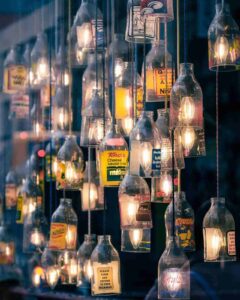Glass bottles and jars, often perceived as mere containers, hold a vast potential for creative repurposing. Among the most enchanting transformations is converting them into terrariums. This guide focuses on the crucial step of safely drill holes in glass bottles, including wine glass bottles, without causing breakage. Whether it’s to create a glass bottle with a hole in the bottom or to enhance its design, our tips will ensure a smooth process.

Section 1 Why Drill Holes in Glass Bottles?
Drilling holes in glass bottles can be both a practical and creative endeavor, serving multiple purposes:
|
○ Creating Terrariums and Planters: One of the most popular reasons for drilling holes in glass bottles is to transform them into terrariums or planters. The hole provides necessary ventilation and drainage, which is crucial for the health of the plants inside. ○ Lighting Projects: Glass bottles with holes can be used to create unique lighting fixtures. By inserting lights, such as LED strings or small bulbs, you can turn a simple bottle into a beautiful, ambient light source. ○ Artistic and Decorative Uses: Artists and DIY enthusiasts often drill holes in glass bottles for artistic projects. These can include decorative vases, unique centerpieces, or part of a larger art installation. ○ Functional Upgrades: In some cases, holes in glass bottles serve functional purposes, such as creating an opening for a dispenser in a bottle-turned-soap-dispenser, or for threading a cord through a bottle that’s being converted into a lamp. ○ Recycling and Upcycling: Drilling holes in glass bottles is a great way to recycle and upcycle. It gives a second life to what would otherwise be waste, turning bottles into useful and decorative items. |
 |
Drilling holes allows for the customization of bottles for personal or commercial use, such as creating bespoke bottle designs for events or as part of a branding strategy. It opens up a world of possibilities for creative, functional, and eco-friendly projects, turning everyday items into unique, handcrafted pieces.
Section 2 Preparation: Tools and Safety
|
▶ Choosing the Right Tools ○ For Drilling: Specialized glass drill bits are recommended. Standard drill bits are not suitable for glass. ○ Without a Drill: Methods like using a hot metal rod or a soldering iron can be explored.
▶ Safety First ○ Always wear safety goggles and gloves. ○ Work in a well-lit, stable environment. |
 |
Section 3 Step-by-Step Guide to How to Drill a Hole in a Glass Bottle
|
▶ Setting Up ○ Mark the Spot: Use a non-permanent marker to mark where you want the hole. ○ Secure the Bottle: Fix the bottle in place using clamps or a vise.
▶ The Drilling Process ○ Start at a Low Speed: Begin drilling at a slow speed to prevent cracking. ○ Use Lubrication: Apply water or oil to the drilling area to reduce heat. ○ Increase Speed Gradually: Once the initial hole is made, you can slightly increase the speed.
▶ Finishing Up ○ Smooth the Edges: Once the hole is drilled, use fine-grit sandpaper to smooth any sharp edges. |
Section 4 Alternative Methods: Drill Hole Through Glass Without a Drill
Hot Metal Rod Technique for Drilling Holes in Glass
▶ Materials Needed:
A thick metal rod (like a screwdriver or a piece of rebar), Heat source (like a blowtorch), Glass bottle, Water for cooling, Safety equipment (gloves, goggles)
▶ Preparation:
○ Clean the glass bottle and remove any labels or residue.
○ Mark the spot on the bottle where you want the hole. You can use a non-permanent marker for this.
○ Secure the bottle in a stable position to prevent it from moving during the process.
▶ Heating the Metal Rod:
○ Using a blowtorch, heat the end of the metal rod until it is glowing red hot. It’s important to ensure that the rod is heated evenly.
○ Safety Note: Wear heat-resistant gloves and safety goggles during this process to protect yourself from burns and any glass breakage.
▶ Applying the Hot Rod to the Glass:
○ Gently press the hot end of the rod against the marked spot on the glass bottle.
○ Apply steady, gentle pressure. Avoid pushing too hard as it might crack the glass.
○ As you press, the heat from the rod will start to melt the glass, creating a hole.
▶ Cooling and Finishing:
○ Periodically, remove the rod and apply a small amount of water to the heated area. This helps to control the temperature and prevent the glass from cracking.
○ Continue the heating and cooling process until the hole reaches the desired size.
○ Once the hole is made, allow the glass to cool down slowly before handling.
|
▶ Smoothing the Edges: ○ After the glass has cooled, use fine-grit sandpaper to smooth out any rough edges around the newly created hole to make it safe to handle.
▶ Safety and Cleanup: ○ Always work in a well-ventilated area and dispose of any glass debris safely. ○ Inspect the bottle for any cracks or weaknesses that may have occurred during the process. This technique requires a bit of practice and patience, and it’s important to always prioritize safety when working with hot materials and glass.
|
Unleashing Creativity with Safety in Mind
Revitalizing empty glass bottles and jars by transforming them into terrariums or a myriad of imaginative creations not only champions eco-conscious living but also unleashes a world of rewarding artistic expression. The art of drilling holes in glass, while demanding patience and precision, is a gateway to repurposing with flair and originality. Armed with the appropriate tools and a steadfast commitment to safety, you stand at the threshold of an inspiring adventure. This journey of safe and artful glass modification breathes new life into discarded bottles, turning them into bespoke pieces of art and utility.
If you want to find more creative decoration ideas for repurposing empty glass bottles and jars, explore our post! It’s a treasure trove of inspiration for those looking to give new life to used glassware. Take a look and unleash your creativity!










